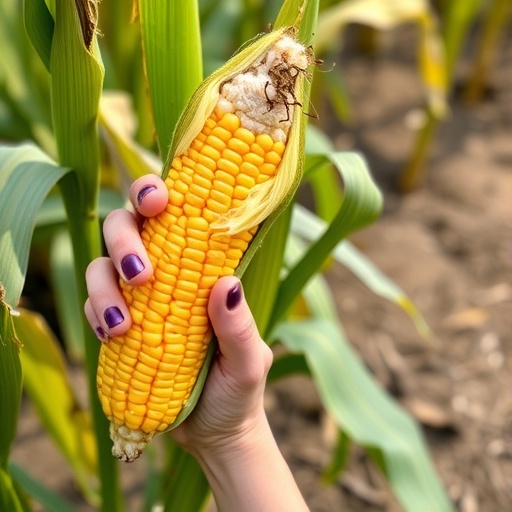Corn stands as one of the most economically significant crops worldwide, with its grain production in the United States alone valued at nearly $80 billion annually. Its critical role in global food security and as a raw material for numerous industrial applications underscores the need for sustainable management strategies to safeguard yields. Central to these strategies has been the widespread use of fungicides to protect corn crops from fungal pathogens that threaten productivity. However, emerging research challenges the conventional understanding of fungicides as purely protective agents, unveiling previously overlooked consequences for the complex ecosystem residing within corn plants.
A groundbreaking investigation conducted by a multidisciplinary team led by research microbiologist Briana Whitaker and research plant pathologist Joseph Opoku, affiliated with the USDA Agricultural Research Service, in partnership with Nathan Kleczewski of Syngenta Biologicals, sheds new light on the subtle yet profound impact of foliar fungicides on the corn microbiome. Published in the esteemed Phytobiomes Journal, this study examines how foliar fungicide applications modulate the community of fungal endophytes inhabiting corn leaves — organisms that live inside plant tissues without causing disease and are increasingly recognized for their roles in promoting plant health and resilience.
The researchers employed traditional culture-based techniques at two distinct agricultural research locations in the Midwestern United States to isolate and identify these foliar fungal endophytes from treated and untreated corn plants. The fungicide applied was systemic, exhibiting multiple modes of action intended primarily to suppress pathogenic fungi. Intriguingly, while the total abundance of culturable fungi was not markedly diminished following fungicide application, the composition of the fungal community experienced significant shifts. These alterations were especially pronounced in the diversity and relative abundance of certain fungal species, which varied conspicuously between the two geographic sites, implicating environment-driven responses within the microbiome.
.adsslot_e0DXUg5B61{width:728px !important;height:90px !important;}
@media(max-width:1199px){ .adsslot_e0DXUg5B61{width:468px !important;height:60px !important;}
}
@media(max-width:767px){ .adsslot_e0DXUg5B61{width:320px !important;height:50px !important;}
}
ADVERTISEMENT
Such findings disrupt the simplistic narrative that fungicides eradicate harmful fungi without collateral effects. Instead, the data reveals a dynamic reconfiguration of the foliar fungal microbiome—a hidden dimension of crop management that has remained largely unexplored until now. These endophytic fungi contribute to nutrient cycling, pathogen suppression, and enhanced stress tolerance in plants, functions essential for maintaining crop vigor and yield under diverse environmental stresses. Hence, any disruption to these beneficial symbionts may inadvertently diminish the plant’s natural defenses and long-term resilience.
In a statement accompanying the publication, Whitaker emphasizes the transformative potential of this discovery. She advocates for a paradigm shift in agricultural practices—moving beyond the narrow goal of pathogen control toward an integrated approach that nurtures the beneficial microbiome alongside disease management. This integrated strategy could harness the synergy between plants and their microbial partners, optimizing the crop environment to support both yield and sustainability.
The implications of this study resonate deeply across multiple disciplines. Plant pathology, traditionally focused on controlling infectious agents, may now incorporate microbiome preservation as a strategic objective. Agronomists and ecologists alike are prompted to reconsider the unintended ecological consequences of fungicide application regimes, while integrated pest management programs are encouraged to embrace microbiome-friendly solutions. Ultimately, these insights pave the way for precision agriculture techniques that monitor and modulate microbial communities to enhance crop performance.
As climate variability and emerging pathogens increasingly challenge agricultural systems, the resilience of key crops such as corn becomes paramount. Beneficial fungal endophytes may represent an underutilized asset in developing adaptive cropping systems that withstand environmental fluctuations and biotic stresses. By maintaining or even augmenting these microbial cohorts, farmers could reduce reliance on chemical inputs and foster agroecosystems that are both productive and sustainable.
The specificity of microbiome responses to fungicides across different locations further underscores the complexity of host-microbe-environment interactions. It suggests that localized environmental factors, including climate, soil properties, and native microbial pools, modulate the sensitivity of fungal communities to chemical disturbances. Consequently, management practices effective in one region may not translate seamlessly elsewhere, highlighting the necessity for site-specific strategies in crop protection.
Looking ahead, continued research is poised to elucidate the functional consequences of altered fungal communities for corn physiology and yield. Understanding which beneficial fungi are most sensitive to fungicides, and how their loss impacts plant health, could inform the development of targeted microbial inoculants or alternative chemical formulations with reduced microbiome disruption. This holistic perspective holds promise for aligning crop protection with environmental stewardship.
The findings presented by Whitaker, Opoku, and colleagues signal a critical turning point in the study of plant-microbe interactions in agroecosystems. They invite scientists, industry stakeholders, and policymakers to expand the scope of sustainable agriculture beyond pathogen management to encompass the preservation and promotion of plant-associated microbiomes. This broadened horizon aligns with global efforts to achieve food security in harmony with ecological resilience.
In conclusion, the revelation that foliar fungicides reshape the fungal endophyte communities within corn leaves without significantly reducing overall fungal presence challenges pre-existing agricultural paradigms. It spotlights a complex microbiome dynamic where beneficial microbes can be affected alongside pathogens, potentially influencing plant health and yield outcomes. As agriculture ventures into the era of microbiome-informed practices, such research offers a visionary blueprint for optimizing crop management through an intricate balance of chemical, biological, and ecological considerations.
Subject of Research: Impact of foliar fungicide applications on the community composition of culturable fungal endophytes in corn leaves.
Article Title: Foliar Fungicide Application Alters the Culturable Foliar Fungal Endophyte Community in Corn
News Publication Date: 21-Jun-2025
Web References:
https://doi.org/10.1094/PBIOMES-09-24-0089-R
Keywords: Fungicides, Farming, Sustainable agriculture, Agriculture, Maize, Crops, Microbiota, Plant ecology
Tags: agricultural research on corncorn microbiome researcheconomic significance of corn productionfoliar fungicide applicationsfungal endophytes in cornfungicide effects on corn healthimpact of fungicides on plant ecosystemsmultidisciplinary research in agriculturePhytobiomes Journal findingsplant health and resiliencesustainable corn management strategiesUSDA Agricultural Research Service studies






